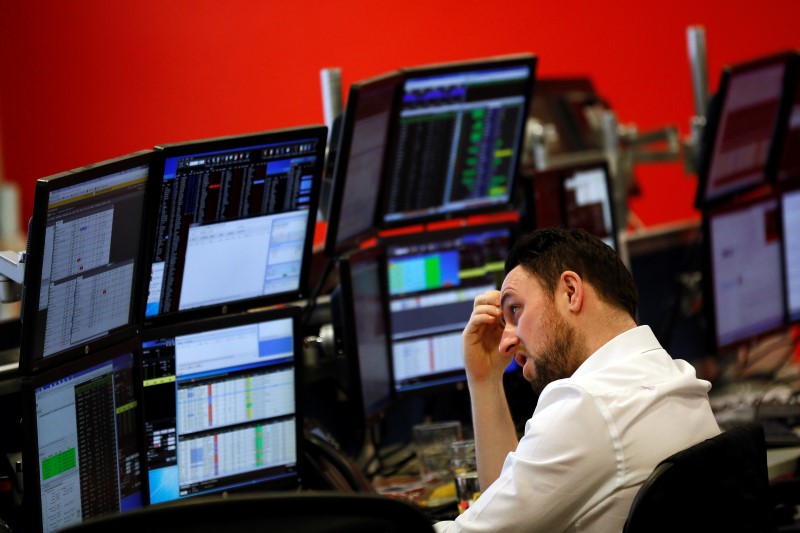© Reuters. An investor looks at a stock quotation board at a brokerage office in Beijing, China January 3, 2020. REUTERS/Jason Lee/File photo
By Amanda Cooper
LONDON (Reuters) – Global shares and commodities slipped on Monday after data showed the Chinese economy is growing a lot more slowly than expected, while the dollar eased as traders ramped up their bets for an imminent end to U.S. rate rises.
China reported economic growth of 0.8% in the second quarter, above the 0.5% forecasted, while the annual pace slowed more than expected to 6.3%, well below expectations for a reading of 7.3%.
Last week brought a broad sweep out of the dollar and into risk assets like equities and emerging market currencies, as well as into bonds, after a cooler reading of U.S. consumer inflation was enough to convince investors that the Federal Reserve could deliver the final rate hike of its monetary policy cycle this month.
The dollar, which fell 0.1% against a basket of major currencies on Monday, staged its biggest weekly fall of 2023 last week, dropping 2.3%, as traders rushed to price out the chances of a September rate rise.
This week’s data macro calendar is light and Fed officials are now in their “blackout period” ahead of the July policy meeting, leaving investors with the big question of whether last week’s market moves will continue or reverse.
“I just can’t help but think we have gone a little bit too far too fast … one cooler inflation number doesn’t exactly mean the Fed are done and dusted and not going to hike again,” TraderX strategist Michael Brown said.
“Obviously, they’re going to hike next week, but after that, markets pretty much think they’re going to be done, and are starting to price in cuts for the first half of next year, which to my mind, is too aggressive,” he said.
“Given that we don’t have a lot on the calendar this week, the path of least resistance is lower for the dollar in the near term,” Brown added.
Global equities, which last week posted their strongest weekly rally since March, edged down 0.1% on Monday, under pressure from a decline in Europe, where weakness in China-sensitive shares like miners knocked 0.3% off the .
U.S. stock index futures were mostly steady on the day, trading between flat and up 0.1% ahead of a packed weak of corporate earnings.
Tesla (NASDAQ:) is the first of the big tech names to report this week, along with Bank of America (NYSE:), Morgan Stanley (NYSE:), Goldman Sachs (NYSE:) and Netflix (NASDAQ:).
Data on U.S. retail sales are expected to show a rise of 0.3% ex-autos, continuing the slower trend but solid enough to fit into the market’s favoured soft-landing theme.
“We continue to look for a modest contraction to take hold toward the end of the year, but the path to a non-recessionary disinflation is starting to look more plausible,” said Michael Feroli, an economist at JPMorgan (NYSE:).
“We expect Fed officials cheered the latest inflation developments, but declaring victory with sub-4% unemployment, and over 4% core inflation, would be reckless.”
PRICED FOR 2024 POLICY EASING
As a result, markets still imply around a 96% chance of the Fed hiking to 5.25-5.5% this month, but only around a 25% probability of yet a further rise by November.
Two-year U.S. Treasury yields, the most sensitive to shifts in rate expectations, were down 2 basis points on the day at 4.728%, just above one-month lows.
The dollar fell 0.3% against the yen to 138.34, 2.4% last week. The euro rose 0.2% to $1.1247, having also surged 2.4% last week to clear its former top for the year at $1.1096.
Sterling rose 0.1% to $1.3105 ahead of UK inflation figures this week, where another high reading would add to the risk of further sizable rate hikes.
“A lift in the core CPI can encourage financial markets to price in even more tightening from the Bank of England and push up towards upside resistance at $1.3328,” said analysts at CBA in a note.
dropped sharply following the China GDP data that cast doubt on demand from the world’s largest importer of energy, just as production in Libya picked up after a temporary outage.
futures were last down 1.6% at $78.60 a barrel. , which is also highly sensitive to Chinese data, dropped 2.1% to $8,490 a tonne.
Read the full article here













